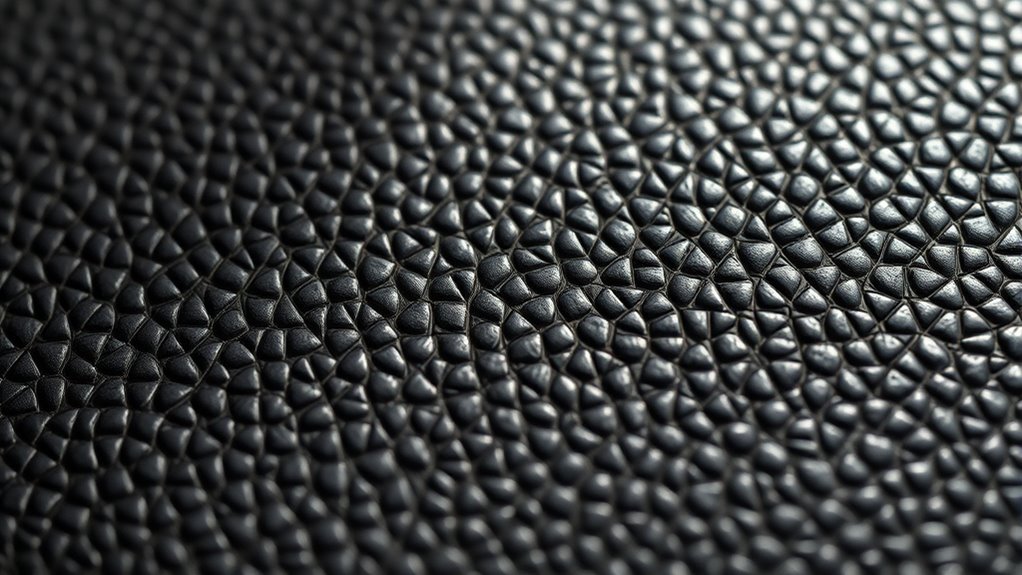Vegan leather is “vegan” because it excludes all animal-derived materials, instead using synthetic, plant-based, or natural options. Most common is synthetic leather made from polyurethane or PVC coatings, mimicking real leather’s look and feel. You’ll also find plant-based options made from fruits like pineapples or apples, and natural materials like cork. To truly understand what makes vegan leather different, explore the various materials and innovations that shape this eco-friendly alternative.
Key Takeaways
- Vegan leather is made without animal-derived materials, using synthetic, plant-based, or natural fibers instead.
- It avoids animal hides, reducing ethical concerns related to animal suffering and exploitation.
- The materials used are typically free from animal fats, gelatin, or other animal-based additives.
- Production emphasizes sustainable, eco-friendly options like plant fibers and biodegradable synthetics.
- Certification labels or transparent brand practices help verify the vegan status of the leather product.
Synthetic Leather: The Most Common Vegan Alternative

Synthetic leather, also known as faux leather or vegan leather, is the most widely used alternative to traditional animal-based leather. Its popularity stems from its synthetic durability, which allows it to withstand daily wear and tear better than some natural leathers. The chemical composition of synthetic leather typically involves polyurethane or PVC coatings layered over a fabric base. This composition gives it a smooth, leather-like appearance while maintaining affordability and versatility. Because it doesn’t involve animal products, it appeals to vegans and environmentally conscious consumers. You’ll find synthetic leather in countless products—from bags to furniture—thanks to its ability to mimic real leather’s look and feel. Its consistent chemical makeup also makes it easier to produce in various colors and finishes, enhancing its appeal across fashion and accessory industries. Additionally, synthetic leather can be manufactured with high-quality materials that improve its environmental footprint compared to traditional leather.
Plant-Based Leather: From Fruits to Fibers
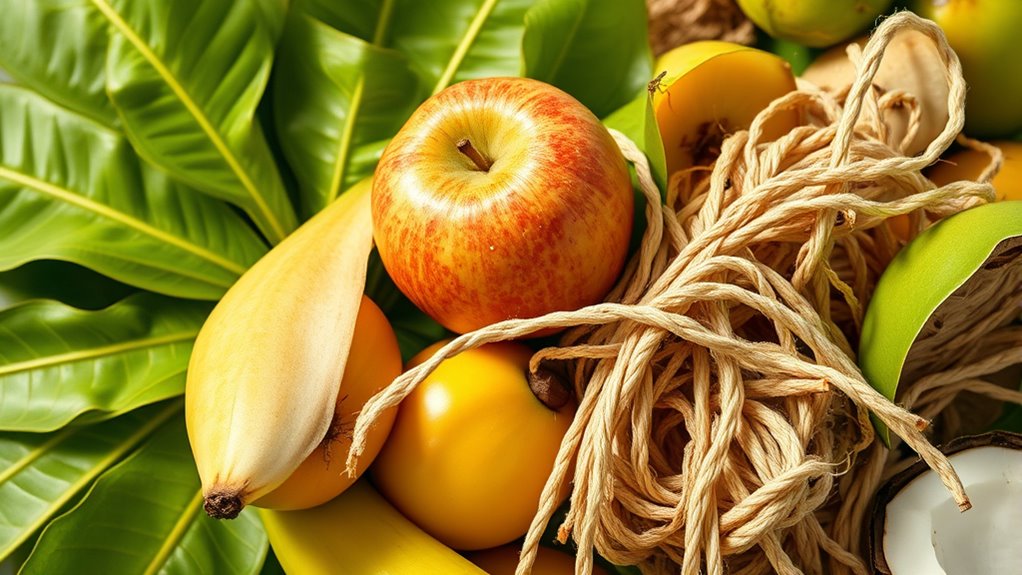
Plant-based leather offers an innovative alternative by transforming natural fibers and fruits into durable, eco-friendly materials. These materials harness the strength of plant fiber durability, enabling them to withstand daily use while remaining sustainable. Fruits like pineapples, apples, and cacti are processed into fibers that can be woven into leather-like textures, reducing reliance on traditional animal hides. However, biodegradability concerns arise with some plant-based leathers, especially those treated with synthetic binders or coatings, which can hinder natural decomposition. To guarantee true sustainability, manufacturers focus on developing plant fibers that break down easily without harmful residues. Additionally, biodegradability is a key factor to consider when evaluating the environmental impact of plant-based leathers, as some treatments may impede natural decomposition. As you explore plant-based leather options, consider how each material balances durability with biodegradability, aligning with your eco-conscious values.
Cork and Other Natural Plant Materials
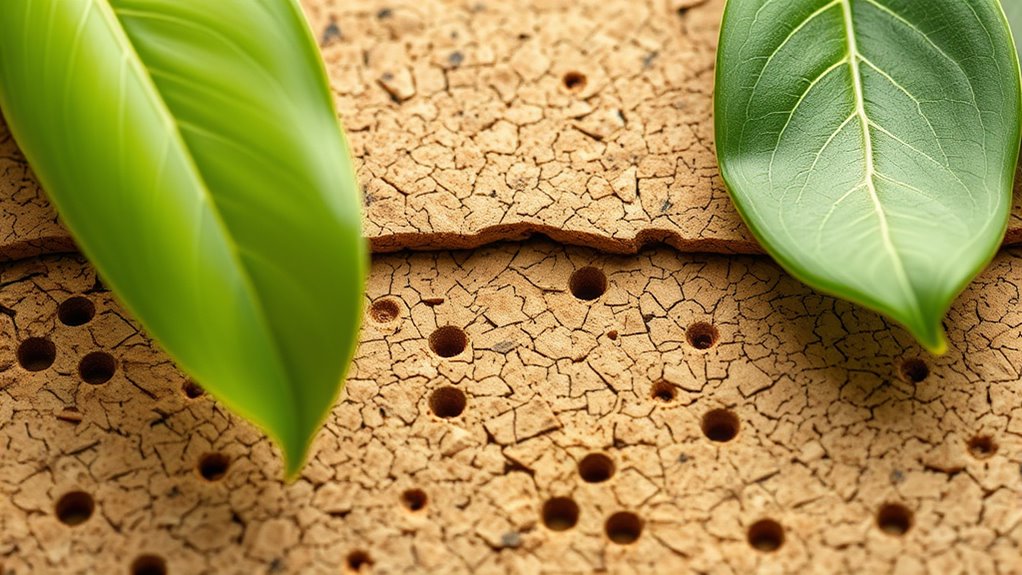
Cork and other natural plant materials are gaining popularity as sustainable alternatives to traditional leather. Cork, in particular, boasts impressive cork sustainability due to its renewable harvesting process—bark is stripped without harming the tree, allowing it to regrow. This makes cork a highly eco-friendly choice. Additionally, cork and similar plant-based materials offer plant-based durability, meaning they can withstand daily wear while remaining flexible and lightweight. These materials are naturally resistant to water, mold, and pests, further enhancing their longevity. Their eco-conscious appeal and functional resilience make them attractive options for those seeking vegan leather alternatives that align with environmental values. As innovation continues, cork and plant-based materials are solidifying their role in the future of sustainable fashion.
Innovations in Lab-Grown Leather
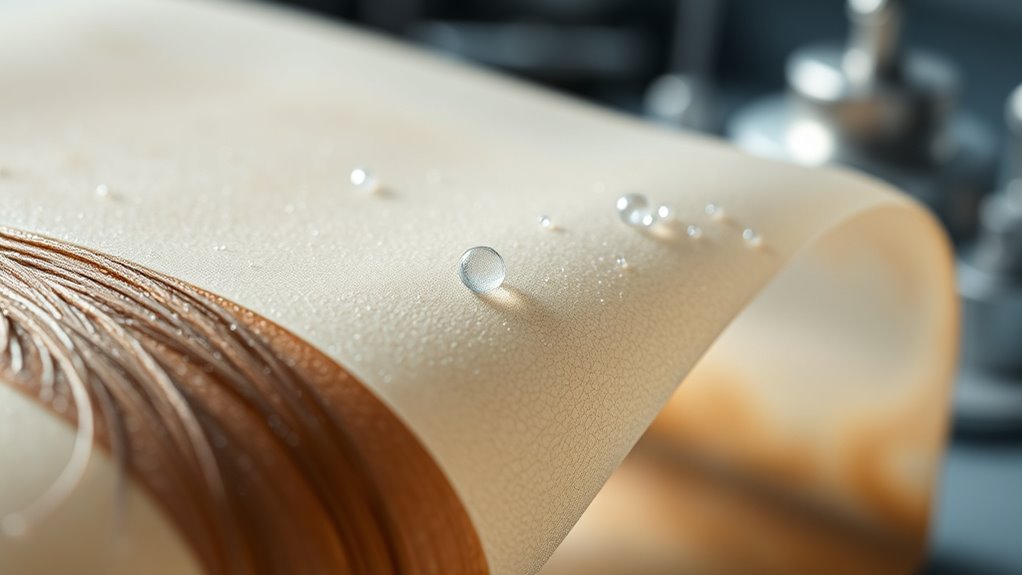
As sustainable materials like cork and other plant-based options gain popularity, innovations in lab-grown leather are pushing the boundaries of eco-friendly fashion even further. Researchers are developing lab-grown leather from cell cultures that mimic animal hide, reducing environmental impact. However, biodegradability challenges remain, as some lab-grown leathers don’t break down easily, raising concerns about waste. Consumer perception also plays a role; many still view lab-grown options as less authentic. To help, companies are working on improving the natural breakdown process and educating buyers about its benefits. Here’s a quick look at some innovations:
| Innovation | Benefit | Challenge |
|---|---|---|
| Biodegradable scaffolds | Easier to break down naturally | Cost and scalability |
| Plant-based growth media | Eco-friendly cultivation | Perception of artificiality |
| Rapid production techniques | Faster market availability | Maintaining quality |
| Enhanced cell culture methods | Better durability | Consumer trust |
Additionally, integrating creative practice principles such as experimentation and resilience can accelerate breakthroughs in sustainable material development.
The Role of Adhesives and Coatings in Vegan Leather
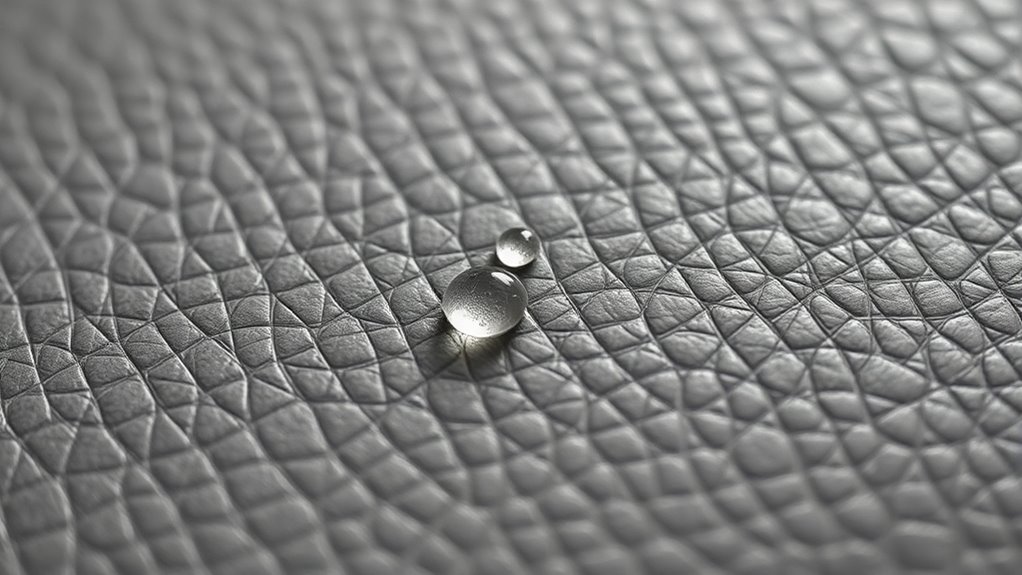
Adhesives and coatings play a crucial role in ensuring that vegan leather is durable, flexible, and visually appealing. The success of vegan leather depends heavily on adhesive formulations that bond layers securely without compromising flexibility or breathability. High-quality adhesives must withstand daily wear and tear while remaining free of animal-derived ingredients. Coating durability is equally important, as it protects the surface from scratches, moisture, and UV damage, maintaining the material’s appearance over time. Modern coatings often incorporate innovative polymers that offer enhanced resilience and eco-friendly properties. Additionally, advancements in material science have led to the development of more sustainable and environmentally friendly adhesive and coating options. By carefully selecting adhesive formulations and ensuring robust coating durability, manufacturers create vegan leather products that meet both aesthetic standards and functional demands, proving that cruelty-free materials can perform just as well as traditional leather.
Ethical and Environmental Considerations in Material Choice

When choosing vegan leather, you should consider how it affects animal welfare, as some materials still rely on animal-derived components. You also need to think about the environmental impact of production, including efforts to reduce pollution and promote sustainability. Additionally, understanding the chemicals used in manufacturing helps you assess the true ethical and environmental footprint of your material choice. Incorporating sustainable storage solutions can further support eco-friendly practices in your lifestyle.
Animal Welfare Impact
Choosing vegan leather considerably reduces animal suffering, making it a more ethical choice than traditional leather. By avoiding fur farming, you prevent animals from enduring cruel confinement and inhumane slaughter. You also eliminate support for industries that often rely on animal testing to develop leather alternatives. Here’s how vegan leather impacts animal welfare:
- Stops fur farming, ending the exploitation of animals for fur coats.
- Reduces demand for animal slaughter, sparing countless lives.
- Avoids animal testing, which often causes pain and distress.
- Promotes compassionate choices that respect animal rights.
- High-quality materials in vegan leather can rival traditional options, providing durability without compromising ethics.
Production Sustainability Efforts
Switching to vegan leather not only benefits animals but also promotes production practices that prioritize sustainability. Many manufacturers implement recycling initiatives to reduce waste and reuse materials, lowering environmental impact. These efforts help conserve resources and minimize landfill contributions. Additionally, companies are actively working to decrease energy consumption during production, making processes more efficient and eco-friendly. By investing in renewable energy sources like solar or wind power, they lower greenhouse gas emissions associated with manufacturing. These sustainability efforts demonstrate a commitment to ethical production that considers the planet’s health. As a consumer, supporting brands that prioritize recycling initiatives and energy efficiency encourages broader industry shifts toward more responsible, sustainable practices in vegan leather production.
Chemical Use and Pollution
While vegan leather offers an ethical alternative to traditional materials, its production can involve significant chemical use that raises environmental and health concerns. Chemical emissions from manufacturing processes can pollute air and water, impacting ecosystems and communities. To understand the impact, consider:
- The release of toxic solvents that threaten local water quality
- Airborne pollutants contributing to smog and respiratory issues
- Waste chemicals that can contaminate soil and waterways
- The challenge of pollution reduction without sacrificing quality
- Cultural and regional breakfast traditions may also influence the types of ingredients and chemicals used in food preparations, reflecting local practices and environmental considerations.
These factors highlight the importance of choosing vegan leathers made with safer chemical practices. By prioritizing innovative materials and cleaner production methods, you can help reduce chemical emissions and support a more sustainable, less polluting industry.
How to Spot Genuine Vegan Leather Products
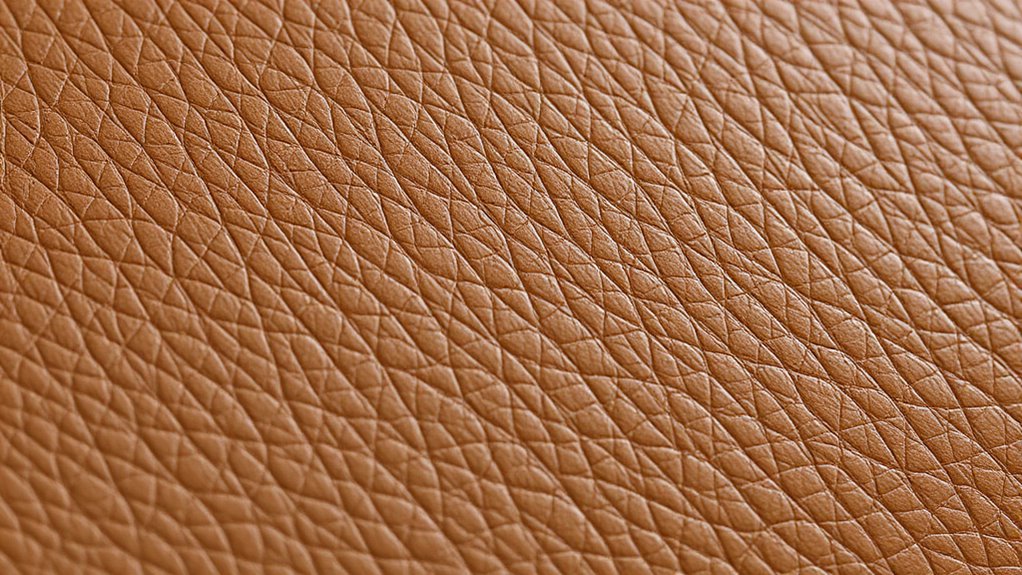
Knowing how to identify genuine vegan leather products can save you from falling for imitation materials. Start by checking synthetic labels; reputable brands clearly state that their product is vegan or synthetic. Be cautious of vague labels like “leatherette” or “faux leather,” which often indicate non-vegan origins. Authentic vegan leather brands prioritize transparency, so research their brand authenticity through reviews or official websites. Feel the material—genuine vegan leather tends to be softer and more flexible than cheap imitations. Look for consistent coloring and stitching, as poor craftsmanship can be a giveaway. Also, consider the price—authentic vegan leather usually costs more due to better quality. By paying attention to labels, brand reputation, and material quality, you can confidently distinguish genuine vegan products from imitations. Additionally, understanding the Flat Iron Bike market can help you recognize high-quality vegan leather used in accessories for durable and sustainable fashion items.
Frequently Asked Questions
How Durable Is Vegan Leather Compared to Traditional Leather?
When comparing vegan leather to traditional leather, you’ll find that durability varies based on materials used. Vegan leather often has a good wear resistance, but it may not be as long-lasting as genuine leather, especially with frequent use. The durability comparison shows that high-quality vegan options can hold up well with proper care, though they might show signs of wear sooner. Overall, it’s a solid choice, but consider your needs for wear resistance.
Can Vegan Leather Be Recycled or Composted?
Imagine vegan leather as a traveler with a unique journey. Its recyclability depends on the material’s composition and the recycling processes available, but many vegan leathers aren’t biodegradable. A biodegradability assessment helps determine if it can break down naturally, yet most require specialized recycling methods. While some brands explore compostable options, overall, vegan leather’s eco-friendliness hinges on innovative recycling and proper disposal methods.
Are All Plant-Based Leathers Completely Cruelty-Free?
Not all plant-based leathers are completely cruelty-free. While they avoid animal cruelty, some processes may still involve environmental impacts like chemical use or pollution. You should check if the production methods prioritize eco-friendly practices, as some brands might compromise environmental health for durability. By choosing truly cruelty-free and eco-conscious options, you support reducing animal cruelty and minimizing environmental impact, aligning your values with your fashion choices.
What Certifications Verify Vegan Leather’s Ethical Claims?
When you’re checking if vegan leather’s ethical claims are verified, look for certifications that emphasize ethical labeling and sustainability standards. Certifications like PETA-Approved Vegan and the Vegan Society ensure the product is cruelty-free and free from animal-derived materials. These labels help you trust that the leather meets strict ethical and environmental criteria, giving you confidence in your sustainable and compassionate choice.
How Does Vegan Leather Perform in Extreme Weather Conditions?
Imagine a chameleon adapting to its environment. Vegan leather, like this chameleon, faces extreme weather with mixed results. It offers decent water resistance, keeping you dry in light rain, but struggles in heavy downpours. Its temperature resilience varies; it might crack in freezing cold or soften in intense heat. So, while adaptable, vegan leather isn’t foolproof against the harshest weather conditions, requiring careful care and usage.
Conclusion
Now that you know what truly makes leather vegan—be it synthetic, plant-based, or lab-grown—you’re armed with superpowers to spot genuine vegan products everywhere. Imagine walking into a store and instantly recognizing the real deal, dodging animal products like a leather detective on a mission. With this knowledge, you can make ethical, eco-friendly choices that could revolutionize the fashion world—because your decisions have the power to change everything, one stylish step at a time.
